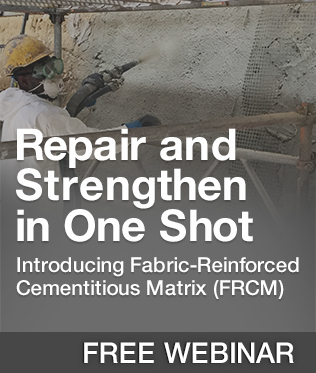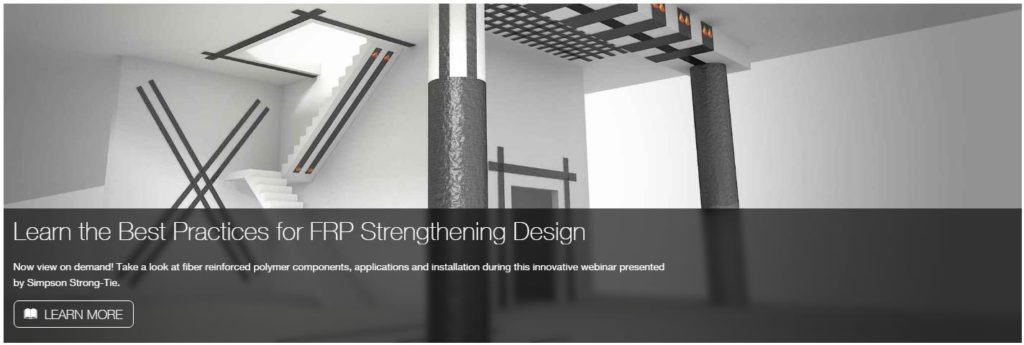On December 1, 2016, Simpson Strong-Tie hosted a webinar titled “The Design Fundamentals of FRP Strengthening” in which Justin Streim, P.E. – one of our Field Engineers – and I discussed the best practices for fiber-reinforced polymer (FRP) strengthening design. The webinar examines FRP components, applications and installation. It also features an example of the evaluation that went into a flexural-beam-strengthening design and discusses the assistance and support Simpson Strong-Tie Engineering Services offers from initial project assessment to installation. Watch the on-demand webinar and earn PDH and CEU credits here.
During the live webinar, we had the pleasure of presenting to more than 1,500 engineers who asked nearly 300 questions during the Q&A session. Here is a curated selection of Q&A from that session:

Can you discuss the flexural strengthening for reinforced masonry walls?
Out-of-plane flexural strengthening can be provided with FRP on the required face of wall. In-plane (or shear wall type) flexural strengthening can also be provided with vertical FRP strips near the ends of walls.
In general, by what percentage can FRP solutions increase the strength of existing concrete shearwalls?
This really depends on the existing wall, but we have seen strength increases of 22% in our testing of one layer of glass fabric installed on 8″ thick ungrouted CMU shearwall.
How does FRP compete in terms of cost? It seems like a cost-prohibitive solution compared to other remediation techniques in the absence of other limiting factors (space limitations, etc.).
FRP may be expensive on a cost/SF basis. However, if you compare it with the materials and labor involved in section enlargement or demolishing parts of buildings, it becomes cost effective. FRP installations are also not unsightly like bolted steel plates or wide flange members slung under concrete slabs/beams.
Who designs the FRP system: Simpson Strong-Tie or the Structural Designer?
The Simpson Strong-Tie Engineering Services group provides the FRP design on most projects, but we have also worked with the engineer on record (EOR) to check their FRP design on projects.
Are there any deformation compatibility issues between carbon fiber or glass and existing reinforcing bar that need to be accounted for in design? Is long-term creep similar to that seen with reinforcing bar?
CFRP and GFRP have different elastic moduli from each other and from steel. When designing an FRP strengthening solution, these differences must be taken into account. For flexural applications, the FRP should be designed to fail from debonding after the internal rebar begins to yield. Creep is taken into account in design equations through reduction factors and stress checks.
Will ACI 440 be updated to include the use of FRP with post-tensioned beams (i.e., unbonded tendons)? Does Simpson Strong-Tie do all stress checks based on gross section properties when total stress is < 12sqrtf’c?
Yes, there is an ACI 440 committee working on including an unbonded PT section in ACI 440.2R. We will work with the EOR to determine what section properties are most appropriate for the specific member being evaluated.
Can you increase deflection limits with FRP?
While FRP does help to limit deflection in members, members with deflection issues are not typically candidates for FRP repair. Prestressed laminates as used in Europe would be a better solution for a member with deflection issues. We do not currently offer prestressed laminates but may in the future.
Does an aesthetic coating interfere with bridge inspection? What is inspection looking for? Delamination or other defects?
A coating could interfere with a visual inspection of the FRP surface. A visual inspection can reveal changes in color, debonding, peeling, blistering, cracking, crazing, deflections, indications of reinforcing-bar corrosion, and other anomalies. In addition, ultrasonic, acoustic sounding (hammer tap) and thermographic tests may indicate signs of progressive delamination. ACI 440 and AC 178 have extensive special inspection recommendations.
Learn more: Webinar – Introducing Fabric-Reinforced Cementitious Matrix (FRCM)
In this free webinar we dive into some very important considerations including the latest industry standards, material properties and key governing limits when designing with FRCM.
Continuing education credits will be offered for this webinar.
Participants can earn one professional development hour (PDH) or 0.1 continuing education unit (CEU).

For complete information regarding specific products suitable to your unique situation or condition, please visit strongtie.com/css or call your local Simpson Strong-Tie RPS specialist at (800) 999-5099.

